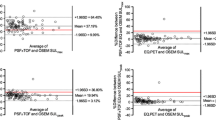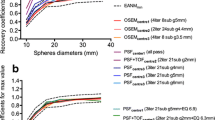Abstract
Background
Evolutions in hardware and software PET technology, such as point spread function (PSF) reconstruction, have been shown to improve diagnostic performance, but can also lead to important device-dependent and reconstruction-dependent variations in standardized uptake values (SUVs). This may preclude the multicentre use of SUVs as a prognostic or diagnostic tool or as a biomarker of the early response to antineoplastic treatments. This study compared two SUV harmonization strategies using a newer reconstruction algorithm that improves lesion detection while maintaining comparability with older systems: (1) the use of a second reconstruction compliant with harmonization standards and (2) the use of a proprietary software tool (EQ.PET).
Methods
PET data from 50 consecutive non-small cell lung cancer patients were reconstructed with PSF reconstruction for optimal tumor detection and an ordered subset expectation maximization (OSEM3D) reconstruction to mimic a former generation PET. An additional PSF reconstruction was performed with a 7 mm Gaussian filter (PSF7, first method), and, post-reconstruction, the EQ filter (same Gaussian filter) was applied to the PSF data (PSFEQ, second method) for harmonization purposes. The 7 mm kernel filter was chosen to comply with the European Association of Nuclear Medicine (EANM) standards. SUVs for all reconstructions were compared with regression analyses and/or Bland–Altman plots.
Results
Overall, 171 lesions were analyzed: 55 lung lesions (32.2%), 87 lymph nodes (50.9%), and 29 metastases (16.9%). In these lesions, the mean PSF7/OSEM3D ratios for SUVmax and SUVpeak were 1.02 (95% CI: 0.93–1.11) and 1.04 (95% CI: 0.95–1.14), respectively. The mean PSFEQ/OSEM3D ratios for SUVmax and SUVpeak were 1.01 (95% CI: 0.91–1.11) and 1.04 (95% CI: 0.94–1.14), respectively. When comparing PSF7 and PSFEQ, Bland–Altman analysis showed that the mean PSF7/PSFEQ ratios for SUVmax and SUVpeak were 1.01 (95% CI: 0.96–1.06) and 1.01 (95% CI: 0.97–1.04), respectively.
Conclusion
The issue of reconstruction dependency in SUV values that hampers the comparison of data between different PET systems can be overcome using two reconstructions for harmonized quantification and optimal diagnosis or using the EQ.PET technology. Both technologies produce similar results, EQ.PET sparing reconstruction and interpretation time. Other manufacturers are encouraged to either emulate this solution or to produce a vendor-neutral approach.




Similar content being viewed by others
References
Bengtsson T, Hicks RJ, Peterson A, Port RE. 18F-FDG PET as a surrogate biomarker in non-small cell lung cancer treated with erlotinib: newly identified lesions are more informative than standardized uptake value. J Nucl Med. 2012;53:530–7. doi:10.2967/jnumed.111.092544.
Konings R, van Gool MH, Bard MP, Zwijnenburg A, Titulaer BM, Aukema TS, et al. Prognostic value of pre-operative glucose-corrected maximum standardized uptake value in patients with non-small cell lung cancer after complete surgical resection and 5-year follow-up. Ann Nucl Med. 2016;30:362–8. doi:10.1007/s12149-016-1070-2.
Kremer R, Peysakhovich Y, Dan LF, Guralnik L, Kagna O, Nir RR, et al. FDG PET/CT for assessing the resectability of NSCLC patients with N2 disease after neoadjuvant therapy. Ann Nucl Med. 2016;30:114–21. doi:10.1007/s12149-015-1038-7.
Shigemoto Y, Suga K, Matsunaga N. F-18-FDG-avid lymph node metastasis along preferential lymphatic drainage pathways from the tumor-bearing lung lobe on F-18-FDG PET/CT in patients with non-small-cell lung cancer. Ann Nucl Med. 2016;30:287–97. doi:10.1007/s12149-016-1063-1.
Yamamoto T, Kadoya N, Shirata Y, Kaneta T, Koto M, Umezawa R, et al. Formula corrected maximal standardized uptake value in FDG-PET for partial volume effect and motion artifact is not a prognostic factor in stage I non-small cell lung cancer treated with stereotactic body radiotherapy. Ann Nucl Med. 2015;29:666–73. doi:10.1007/s12149-015-0991-5.
Lee YS, Kim JS, Kim KM, Kang JH, Lim SM, Kim HJ. Performance measurement of PSF modeling reconstruction (True X) on Siemens Biograph TruePoint TrueV PET/CT. Ann Nucl Med. 2014;28:340–8. doi:10.1007/s12149-014-0815-z.
Panin VY, Kehren F, Michel C, Casey M. Fully 3-D PET reconstruction with system matrix derived from point source measurements. IEEE Trans Med Imaging. 2006;25:907–21.
Taniguchi T, Akamatsu G, Kasahara Y, Mitsumoto K, Baba S, Tsutsui Y, et al. Improvement in PET/CT image quality in overweight patients with PSF and TOF. Ann Nucl Med. 2015;29:71–7. doi:10.1007/s12149-014-0912-z.
Tong S, Alessio AM, Kinahan PE. Evaluation of noise properties in PSF-based PET image reconstruction. IEEE Nucl Sci Symp Conf Rec. 1997;2009(2009):3042–7.
Tong S, Alessio AM, Kinahan PE. Noise and signal properties in PSF-based fully 3D PET image reconstruction: an experimental evaluation. Phys Med Biol. 2010;55:1453–73. doi:10.1088/0031-9155/55/5/013.
Bellevre D, Blanc Fournier C, Switsers O, Dugue AE, Levy C, Allouache D, et al. Staging the axilla in breast cancer patients with (1)(8)F-FDG PET: how small are the metastases that we can detect with new generation clinical PET systems? Eur J Nucl Med Mol Imaging. 2014;41:1103–12. doi:10.1007/s00259-014-2689-7.
Lasnon C, Hicks RJ, Beauregard JM, Milner A, Paciencia M, Guizard AV, et al. Impact of point spread function reconstruction on thoracic lymph node staging with 18F-FDG PET/CT in non-small cell lung cancer. Clin Nucl Med. 2012;37:971–6. doi:10.1097/RLU.0b013e318251e3d1.
Rogasch JM, Steffen IG, Hofheinz F, Grosser OS, Furth C, Mohnike K, et al. The association of tumor-to-background ratios and SUVmax deviations related to point spread function and time-of-flight F18-FDG-PET/CT reconstruction in colorectal liver metastases. EJNMMI Res. 2015;5:31. doi:10.1186/s13550-015-0111-5.
Parvizi N, Franklin JM, McGowan DR, Teoh EJ, Bradley KM, Gleeson FV. Does a novel penalized likelihood reconstruction of 18F-FDG PET-CT improve signal-to-background in colorectal liver metastases? Eur J Radiol. 2015;. doi:10.1016/j.ejrad.2015.06.025.
Teoh EJ, McGowan DR, Bradley KM, Belcher E, Black E, Gleeson FV. Novel penalised likelihood reconstruction of PET in the assessment of histologically verified small pulmonary nodules. Eur Radiol. 2015;. doi:10.1007/s00330-015-3832-y.
Teoh EJ, McGowan DR, Macpherson RE, Bradley KM, Gleeson FV. Phantom and clinical evaluation of the Bayesian penalized likelihood reconstruction algorithm Q.Clear on an LYSO PET/CT system. J Nucl Med. 2015;. doi:10.2967/jnumed.115.159301.
Boellaard R, Delgado-Bolton R, Oyen WJ, Giammarile F, Tatsch K, Eschner W, et al. FDG PET/CT: EANM procedure guidelines for tumour imaging: version 2.0. Eur J Nucl Med Mol Imaging. 2015;42:328–54. doi:10.1007/s00259-014-2961-x.
Boellaard R, O’Doherty MJ, Weber WA, Mottaghy FM, Lonsdale MN, Stroobants SG, et al. FDG PET and PET/CT: EANM procedure guidelines for tumour PET imaging: version 1.0. Eur J Nucl Med Mol Imaging. 2010;37:181–200. doi:10.1007/s00259-009-1297-4.
da Silva AM, Fischer A. WE-AB-204-05: harmonizing PET/CT quantification in multicenter studies: a case study. Med Phys. 2015;42:3660. doi:10.1118/1.4925881.
Graham MM, Wahl RL, Hoffman JM, Yap JT, Sunderland JJ, Boellaard R, et al. Summary of the UPICT protocol for 18F-FDG PET/CT imaging in oncology clinical trials. J Nucl Med. 2015;56:955–61. doi:10.2967/jnumed.115.158402.
Lasnon C, Desmonts C, Quak E, Gervais R, Do P, Dubos-Arvis C, et al. Harmonizing SUVs in multicentre trials when using different generation PET systems: prospective validation in non-small cell lung cancer patients. Eur J Nucl Med Mol Imaging. 2013;40:985–96. doi:10.1007/s00259-013-2391-1.
Kelly MD, Declerck JM. SUVref: reducing reconstruction-dependent variation in PET SUV. EJNMMI Res. 2011;1:16. doi:10.1186/2191-219X-1-16.
Quak E, Le Roux PY, Hofman MS, Robin P, Bourhis D, Callahan J, et al. Harmonizing FDG PET quantification while maintaining optimal lesion detection: prospective multicentre validation in 517 oncology patients. Eur J Nucl Med Mol Imaging. 2015;42:2072. doi:10.1007/s00259-015-3128-0.
Laffon E, Lamare F, de Clermont H, Burger IA, Marthan R. Variability of average SUV from several hottest voxels is lower than that of SUVmax and SUVpeak. Eur Radiol. 2014;24:1964–70. doi:10.1007/s00330-014-3222-x.
Lodge MA, Chaudhry MA, Wahl RL. Noise considerations for PET quantification using maximum and peak standardized uptake value. J Nucl Med. 2012;53:1041–7. doi:10.2967/jnumed.111.101733.
Sunderland JJ, Christian PE. Quantitative PET/CT scanner performance characterization based upon the society of nuclear medicine and molecular imaging clinical trials network oncology clinical simulator phantom. J Nucl Med. 2015;56:145–52. doi:10.2967/jnumed.114.148056.
Quak E, Le Roux PY, Lasnon C, Robin P, Hofman MS, Bourhis D, et al. Does PET SUV harmonization affect PERCIST response classification? J Nucl Med. 2016. doi:10.2967/jnumed.115.171983.
Kuhnert G, Boellaard R, Sterzer S, Kahraman D, Scheffler M, Wolf J, et al. Impact of PET/CT image reconstruction methods and liver uptake normalization strategies on quantitative image analysis. Eur J Nucl Med Mol Imaging. 2015;. doi:10.1007/s00259-015-3165-8.
Hasenclever D, Kurch L, Kluge R. Sources of variability in FDG PET imaging and the qPET value: reply to Laffon and Marthan. Eur J Nucl Med Mol Imaging. 2014;41:2155–7. doi:10.1007/s00259-014-2880-x.
Hasenclever D, Kurch L, Mauz-Korholz C, Elsner A, Georgi T, Wallace H, et al. qPET - a quantitative extension of the Deauville scale to assess response in interim FDG-PET scans in lymphoma. Eur J Nucl Med Mol Imaging. 2014;41:1301–8. doi:10.1007/s00259-014-2715-9.
Pierce LA 2nd, Elston BF, Clunie DA, Nelson D, Kinahan PE. A digital reference object to analyze calculation accuracy of PET standardized uptake value. Radiology. 2015;277:538–45. doi:10.1148/radiol.2015141262.
Acknowledgements
Dr. Alison Johnson, François Baclesse cancer Centre, France, is thanked for her critical review of the manuscript.
Author information
Authors and Affiliations
Corresponding author
Ethics declarations
Conflict of interest disclosure
None.
Ethics approval
Informed consent was waived for this type of study by the local ethics committee (Ref A12-D24-VOL13, Comité de protection des personnes Nord-Ouest III).
Additional information
P. Dô, Y. Oulkhouir, and J. Madelaine contributed equally.
Electronic supplementary material
Below is the link to the electronic supplementary material.
12149_2016_1135_MOESM1_ESM.tiff
Supplemental figure 1: Effect of harmonization strategies on the liver background. For left to right, PSF and OSEM3D values, PSF7 and OSEM3D values and PSFEQ and OSEM3D values were compared using Bland-Altman plots. Upper panel (a) displays SUVmean values and lower panel (b) SUVpeak values (TIFF 7542 kb)
Rights and permissions
About this article
Cite this article
Lasnon, C., Salomon, T., Desmonts, C. et al. Generating harmonized SUV within the EANM EARL accreditation program: software approach versus EARL-compliant reconstruction. Ann Nucl Med 31, 125–134 (2017). https://doi.org/10.1007/s12149-016-1135-2
Received:
Accepted:
Published:
Issue Date:
DOI: https://doi.org/10.1007/s12149-016-1135-2




